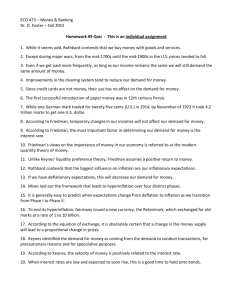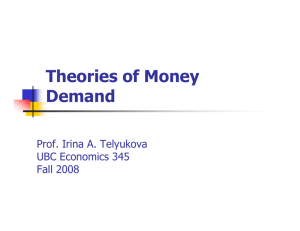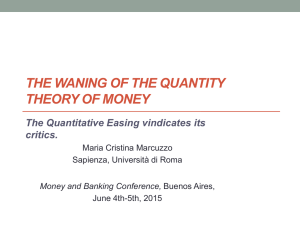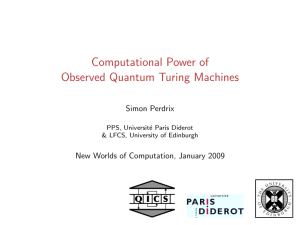The Demand for Money
advertisement
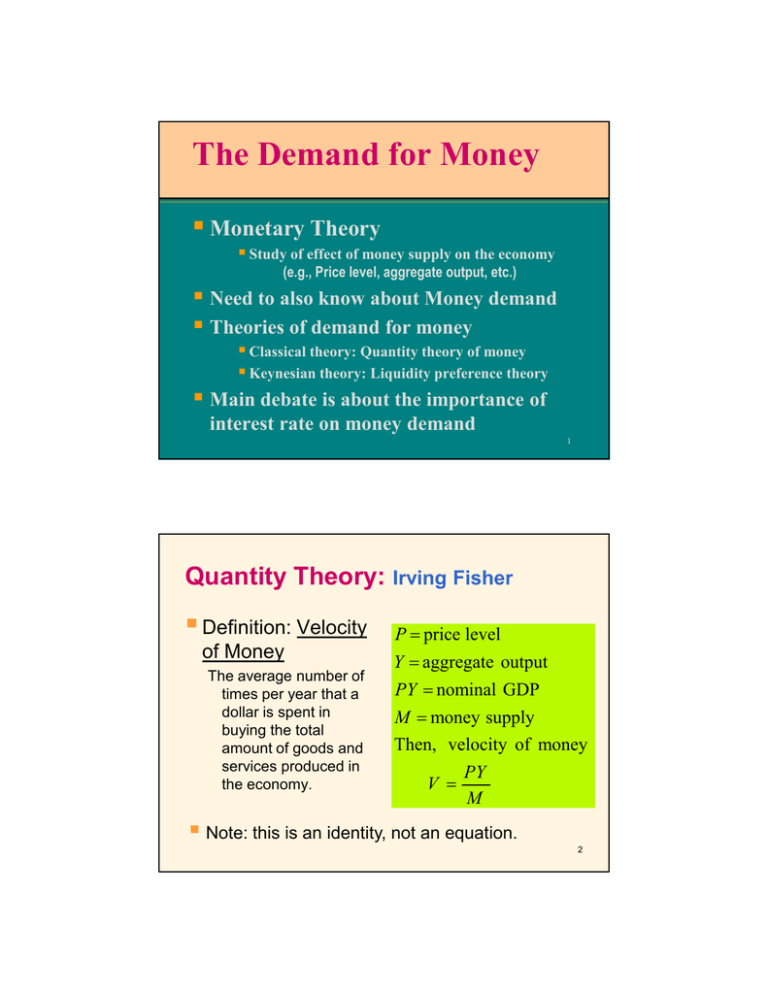
The Demand for Money
Monetary Theory
Study of effect of money supply on the economy
(e.g., Price level, aggregate output, etc.)
Need to also know about Money demand
Theories of demand for money
Classical theory: Quantity theory of money
Keynesian theory: Liquidity preference theory
Main debate is about the importance of
interest rate on money demand
1
Quantity Theory: Irving Fisher
Definition: Velocity
of Money
The average number of
times per year that a
dollar is spent in
buying the total
amount of goods and
services produced in
the economy.
P = price level
Y = aggregate output
PY = nominal GDP
M = money supply
Then, velocity of money
PY
V =
M
Note: this is an identity, not an equation.
2
Turning it into a Theory
The Quantity Theory
Fisher’s assumption
Velocity depends on the institutions and the
technological features of the economy
⇒ V is very slow to change and reasonably
constant in the short run
Then, Money supply is proportional to nominal
GDP
M=
1
V
{
× PY = k × PY
constant by
assumption
3
Quantity Theory to
Quantity Theory of Money Demand
When money market is in equilibrium
⇒ Money supply = Money demand
⇒ M = Md
[Note: for classical economists, market is always in equilibrium]
Then, we have the quantity theory of demand
for money:
M d = k × PY
1
where, k = = constant velocity
V
4
QTM Implications
Demand for money is determined by
The level of transactions generated by the level of nominal
money income PY
The institutions and technology in the economy
Classical economists believed in flex price
If Y relatively fixed (in short run) ⇒ M and P are proportional
⇒ ↑ in money supply only leads to an ↑ in price level
⇒ Neutrality of money (money cannot affect output)
Interest rate has no role in money demand
Md
= k × Y = f (Y )
M = M = k × PY ⇒
P
i.e., real money holding is a function of income only.
d
5
Velocity not really constant!
Prior to 1950 very large swings in velocity, after that still quite large.
Lack of data before WWII.
After the Great Depression, new thinking emerged.
6
Keynesian Thinking
The General Theory of Employment, Interest,
and Money [a.k.a. “The General Theory”]
Abandon the view that velocity is constant
Adopt the view that interest rate matters
Mr. Keynes’s asked a very basic question:
“Why do people hold money?”
7
Motives Behind DD for Money
Transaction motive
Transactions are assumed to be proportional to income
Precautionary motive
Unexpected spending
Also proportional to income
How about interest rate?
How does it affect money demand?
Interest rate is the opportunity cost of holding money.
8
Demand for Money
Cash balance is the
transaction demand for
money.
Example: $1000 a month
Spend over time
Ave cash balance = $500
9
Demand for Money
Consider an interest yielding
bond (i=1%)
New situation:
Ave cash balance = $250
Interest earnings is $2.50
(=1/2*500*1%)
What if interest rate
increases to 5%?
Transaction costs of bond
buying and selling
Balance between opportunity
cost and transaction costs
Transaction demand also
depends on i
↑ i → ↓ transaction dd
10
Demand for Money
transaction demand for money also depends
on i
If i rises, transaction demand will decrease
Same analysis and conclusion holds for
precautionary demand for money
The basic logic is that opportunity cost of
holding money is i
11
Keynesian Money Demand
Keynes’s money demand:
Md
= f (i, Y )
+
−
P
Real money demand depend on both income and
interest rate
12
Implications of Keynes
Md
= f (i, Y )
+
−
P
Money demand negatively depends on I
Money demand not stable because both i and Y
fluctuate a lot
13
Implications of Keynes
Md
= f (i, Y )
+
−
P
From the definition of velocity,
PY P
= d .Y [in equilibrium M d = M ]
M M
1
Y
=
.Y =
f (i , Y )
f (i, Y )
V=
Velocity depends on interest i
i fluctuates a lot and so does V (velocity not constant)
↑i → ↓ money holding
→ same money being transacted more times → ↑V
14
Friedman: Modern QTM
Md
= f ( Yp )
P
What is Yp?
Friedman’s measure of wealth.
Present discounted value of all expected future
income, or expected average long-run income
As Yp increase, money demand increases
Has much less short run fluctuations than current
income
15
Implications of Friedman’s Md
Md
= f ( Yp )
P
Md insensitive to interest rate changes
Because Yp does not fluctuate a great deal in the
short-run, Md should be quite stable
[Note: Keynian Md not very stable]
V=
Y
f (Y p )
⇒ not constant but quite predictable
Velocity in Friedman is predictable because the
relationship between Y and Yp is usually quite
predictable
16
About Velocity
QTM : V =
1
k
⇒ constant (i.e. completely predictable)
Y
⇒ fluctuates a lot (unpredictable)
f (i, Y )
Y
Friedman : V =
⇒ not constant but quite predictable
f (Yp )
Keynes : V =
17
Money Supply
1
M = × PY
V
1
× Aggregate Spending
∴ Money Supply =
Velocity
V=
PY
M
⇒
QTM: since velocity is constant, can affect aggregate spending
with money supply
Keynes: since velocity is unpredictable, monetary policy may
not be an effective tool to affect aggregate spending
Friedman: although velocity not constant it is quite predictable.
Hence, can still affect aggregate spending with money supply
18
Procyclical Movement of V
QTM : V =
1
k
⇒ constant
Friedman : V =
Keynes : V =
Y
⇒ Y and V move together
f (Y p )
Y
f (i, Y )
⇒ i and V move together
QTM: cannot explain
Keynes: Y and i move together ⇒ V procyclical
Friedman: Yp stable, business cycle fluctuations
affect Y more ⇒ V procyclical
19
Empirical Evidence
Velocity not constant
⇒ does not support QTM
Money demand functions not stable since 1973
⇒ does not support Friedman
Money demand is sensitive to interest rates
⇒ does not support Friedman
Money supply is an effective tool to influence
aggregate spending
⇒ does not support Keynes
20


